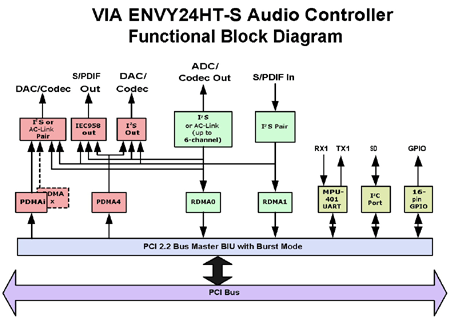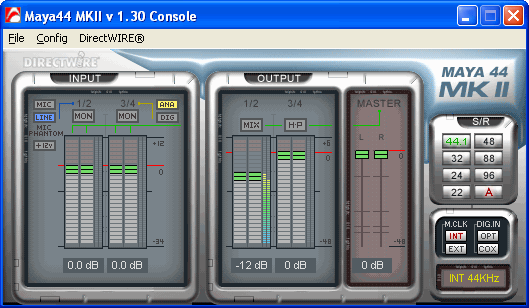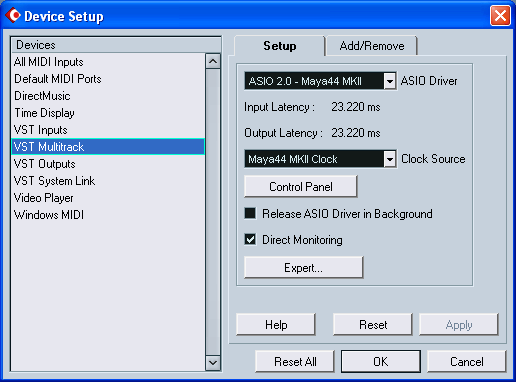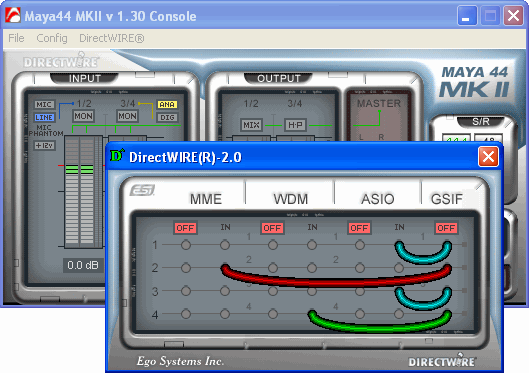 |
||
|
||
| ||
Today we are to test Audiotrak MAYA44 MKII sound card made by the consumer products division of ESI (Ego Systems Inc), the well-known professional sound interface manufacturer. Our steady readers might remember that we have already tested a number of Audiotrak sound cards, including Prodigy7.1, Prodigy192, and MAYA44, which seemed like interesting solutions in their class. The company positions MAYA44 MKII as a long-anticipated return of the "people’s" popular and successful MAYA44 (this is further supported by the “MAYA44 finally returns!!!” slogan at the official website). In its time MAYA44 gained enough popularity being simple and all-sufficient for a professional home studio. The “44” postfix stands for 4 inputs and 4 outputs. If you use these as stereo, you also get mic-in, line-in, headphones-out, and line-out plus digital optical and coaxial outputs.  ESI traditionally offers stylish and well-designed bundle The company positions this model as a DTMP (Desktop Music Production) product. The card is budgetary as much as possible and the stylish bundle adds only the manual and a software CD. On the other hand, users don’t have to overpay for unnecessary options. This approach seems ideal both our local (Russian) and Asian markets. MAYA44 MKII (as any other ESI Waveterminal 192L/X solution) can be used with an ESI MI/ODI/O (midi input/output, digital input/output) optional module. MAYA44 MKII is favourably distinguished from other gaming products offered for similar price by:
From MAYA44 this MKII “revision” differs by higher-quality converters, 24/96 support, more powerful headphones amplifier, and improved control panel. Disadvantages (like no hardware 3D sound and EAX support for games) are so only if you misunderstand the purpose of this sound card. But, fortunately, you can just install two or three more sound cards into your system to use each accordingly its purpose. Forestalling a couple of hundreds emails in my mailbox, I must say that currently I’d recommend for digital music making and recording Lynx L22 (of course with a external hardware mixer and vacuum-tube preamplifier-compressor for good microphone), while games should unambiguously be played with a usual (non-Platinum) Audigy2 ZS. Besides, don’t forget about the appropriate short-range active monitors otherwise you might not see the difference between professional sound card and an AC'97 codec which is integrated on motherboard.  Red PCB, high element density, no low-quality electrolytes 
DSP, VIA Envy24HT-S, is interesting and powerful enough. It differs from Envy24HT by fewer input and output channels.  And Wolfson WM8731 codecs can confuse by low characteristics in specification. On the other hand, unlike AC'97 these are fully-fledged multibit delta-sigma I2S codecs with assigned sampling frequency; well thought-out line and mic signal analog amplification before ADC; mic preamplifier and headphones buffer.
Anyway, the actual quality will become clear after RMAA and auditory tests and comparison to rival solutions. The control panel is designed as a single window that hosts everything necessary. To the left are input and output sliders. To the right are digital modes and sampling rate buttons. All sliders, except the master volume, have level indicators. Besides, the control panel provides channelwise volume controls.
 The menu is rather simple. It allows for manual mouse wheel increments for level adjustments. Latency – buffer size in samples. Gang Mode – simultaneous left and right channel volume adjustment (for stereo signals). To better understand input and output interaction, take a look at MAYA44 MKII flowchart taken from the user’s manual: 
RMAA 5.3 testing All tests were conducted using the Lynx Two reference card (117 dB SNR), low-noise microphone cable, Proel, with gold-plated connectors. Lynx Two input sensitivity was the standard –10dBV. I must mark that MAYA44 MKII, like the majority of professional sound cards, meets signal-level standards that simplifies interfacing with various sound devices. Measurements were made in RMAA 5.3 via MME/WDM interface through AES17 low-and-high-pass filter (20Hz – 20kHz) that we now use in every test. Front output As usually the tests start with the most popular modes used for CD-DA (16/44) and DVD-Video (16/48) playback. Mode: 16-bit, 44.1kHz
Summary: Excellent (More details) Mode: 16-bit, 48kHz
Summary: Excellent (More details) We’ve repeatedly mentioned that from the angle of sound quality the total integrated parameter values and their literary marks are less valuable than spectrograms. The most interesting parameters are obviously THD and IMD. Intermodulation was measured by a dual-tone signal, 60Hz @ -5dB and 7000Hz @ -17dB exactly meeting the SMPTE RP120-183 (Society of Motion Picture and Television Engineers) standard.  CCIF measurements (19kHz and 20kHz @ -12dB) also indicated rather clear signal spectrum. By the way, to measure acoustic intermodulation it's better to use frequencies defined by DIN45403 (250Hz and 8kHz). Naturally, all of the above is possible in RMAA 5.3. Dynamic range test is even more interesting. It shows SNR in signal presence, dynamic reserve between full scale level and noise floor as well as the low-volume signal playback quality.  Note there's no traces of distortions and noise in the signal spectrum! (16-bit/44kHz, music CD playback mode)
Mode: 24-bit, 44.1kHz
Summary: Excellent (More details) Mode: 24-bit, 96kHz
Summary: Excellent (More details) So, we obtained the result close to 100dBA claimed for card’s converters only in 24-bit modes as expected. The fact is that 16-bit signal dynamic range is limited for any converters by the theoretical border of the format itself. Besides the simple 20 log 2^N formula for unweighted signal, there’s more straight-forward equation for RMS noise floor that depends on bit depth, sampling rate and spectrum width, considering TPDF dithering:
Line-In Line-In results were a real surprise being even better than stated in the technical specs! It seems the company squeezed as much quality from it as possible.
This authorizes MAYA44 MKII as a quantization interface for beginner practice and home studio drafts and sketches that require further reprocessing on some higher-quality equipment. Digital input As a receiver we used Lynx Two that indicated the following on the integrated cymometer:
Both of these important parameters are often unachievable for multimedia/gaming sound cards. The exception is Envy24/HT-based models like Audiotrak Prodigy 7.1 or M-Audio Revolution 7.1. However, at a slightly higher price they are less handle for music making. Mode: 16 bit 44,1 kHz
Summary: Excellent (More details) It’s interesting that the card transmits the signal without any errors and distortions caused by quantization, while the transmitted signal spectrum differs from the source spectrum. Fortunately, changes in digital signal are very slight and resemble re-dithering applied at hardware channel mixing in Envy24HT-S. So, the 1dB dynamic range reduction will hardly be noticeable on affordably priced equipment.  24-bit/96kHz support is also excellent.
Summary: Excellent (More details) Still, Lynx Two slightly surpasses Maya44 in digital results indicating -149.2dB in the noise level test and 133.3dB dynamic range (this might be caused by a more accurate DSP or the notorious transceiver-receiver jitter). Also indicative is the price difference of these two cards that exceeds $1000. :) However, don’t forget that Lynx has a built-in temperature compensator and quartz frequency auto-calibration. As well as additional BNC connectors for clocking and LTC signal input/output required for synchronization with other equipment. And Maya44 MKII is a balanced and complete “turn-key” solution for a budget studio or some outdoor use. DirectSound capabilities Being placed in an intermediate class, this device provides some benefits for its user. Unlike the highly tailored professional interfaces that might work only in respective applications, Maya44 MKII, similar to its predecessor, feels great in DirectSound applications, including DVD and WMP9 playback and games. I shall not fail to kick guys from Lynx Studio technical support that only shake their heads when asked about incorrect drivers operation and reboots caused by us trying to use the card with WinDVD 5.3 Platinum (to play DVD-Audio). RightMark 3DSound 1.01 diagnosticsDevice: 1-Maya44 MKII Ch12 (Mam2Wdm.sys) Features: Rates: Free buffers stats: Max buffers stats: Misc stats: Audio transfer speed (software): 2.137 Mb/sec. Unlike multimedia/gaming Audiotrak Prodigy 7.1, there’s no driver/hardware DirectSound support based on Sensaura. DirectSound3D is realized in games via Microsoft’s primitive software emulation algorithms. Operation in Cubase SX 2 Operation in professional applications was tested with the Steinberg Cubase SX 2.01 audio/MIDI sequencer. The turned-up real task was to compose something relaxing for our readers for the New Year. As an object we selected “Flute” created by Grigory Liadov in Steinberg Halion sampler. It took us about two hours to create our
  The card successfully passed the examination without any criticism. We had just to select right latency in card’s control panel.  All ESI cards feature the DirectWire technology of flexible signal routing between various interfaces. When there were not good VST samplers supporting AKAI and GIG the DirectWire was just vital. However, today it can be of use as well.  Subjective auditory testing Music testing To conduct this testing we used Event 20/20bas studio monitors and the audiophile section of Pioneer AX5i receiver connected via analog in the direct mode and B&W 60X S3 speakers. Lynx Two was naturally used as a reference device. Here is what we came to after testing the card on the highest-quality music material. The card sounded surprisingly good: neutral enough, without dirt and tinges peculiar to sound cards with cheap converters. The key difference from the reference sound was the lack of proper onrush sharpness and the lack of high-frequency clarity that resulted in slightly reduced stereo panorama. Answering the popular trend of selecting sound cards exclusively for high-quality music playback, we compared MAYA44 MKII to Audigy2 ZS. Recently Creative cards (namely Audigy2/Audigy2ZS) have been obtaining high-quality converters despite their gaming purpose and DSP EMU10K2 architecture specifics. This enables them to compete with semi-professional equipment. When we compared Audiotrak Prodigy 7.1 and Audigy2 we gave preference to Prodigy 7.1 for its slight superiority. But this time it’s right opposite. Creative card sounded with noticeably more details and provided sharper onrush and better stereo panorama. To position the quality of MAYA44 MKII even more precise, we state that it’s placed above al multimedia/gaming cards, but still below Prodigy 7.1, Audigy2, Revolution 7.1, Aureon 7.1, etc. It seems like intentional marketing position implied by ESI, so its Audiotrak products do not interfere within the series. Like, if you need much better converters and a professional sound card, purchase ESI Waveterminal 192L for a twice higher price. Of course, card differences are negating to zero alongside the reduction of sound section price. Again we underline that it’s a pity, but users searching for high-quality PC sound will stumble upon certain problems. At the moment we recommend you not to buy expensive miniature PC sound systems as they don’t provide proper quality appropriate to modern sound card capabilities. It would be better to pay attention to short-range pro-audio monitors or, given you lack funds, to at least wooden stereo speakers from Defender or Microlab. Headphones soundTo test the headphones-out we used Sennheiser HD600 headphones. HP button in MAYA44 MKII control panel started playback from the first virtual stereo device on the second physical stereo output operating as headphones-out. The card provided the loud clear signal undistorted even at maximal volume. Card’s codec has an integrated switching buffer for low-impedance (16-32 ohm) headphones (this is not related to our 300-ohm HD600). Nevertheless, besides the line-out, MAYA44 MKII has a separate physical output that can be used as a second line-out as well as the special headphones-out. So, unlike usual sound cards, our test object eliminates the problem of swapping the back-panel line-out either for speakers, or headphones. This is a clear and obvious advantage. By the way, the more expensive professional sound cards do not have such feature only because they imply a compulsory external hardware mixer console. Conclusions MAYA44 MKII sound card is an excellent “all-in-one” budget solution clearly positioned as an entry-level pro equipment. The professional Envy24HT-S and two Wolfson WM8731 I2S stereo codecs is a fine example of a well-balanced design. The card doesn’t provide modern level of record quality, however it has a comprehensive number of features and excellent drivers for professional applications. And those fans of ESI/Audiotrak, who need multichannel DVD output and higher-quality converters for playback, might consider buying Audiotrak Prodigy 7.1 or even ESI Waveterminal 192L. Pros
Contras
Maxim Liadov (maxim@ixbt.com)
Write a comment below. No registration needed!
|
Platform · Video · Multimedia · Mobile · Other || About us & Privacy policy · Twitter · Facebook Copyright © Byrds Research & Publishing, Ltd., 1997–2011. All rights reserved. |